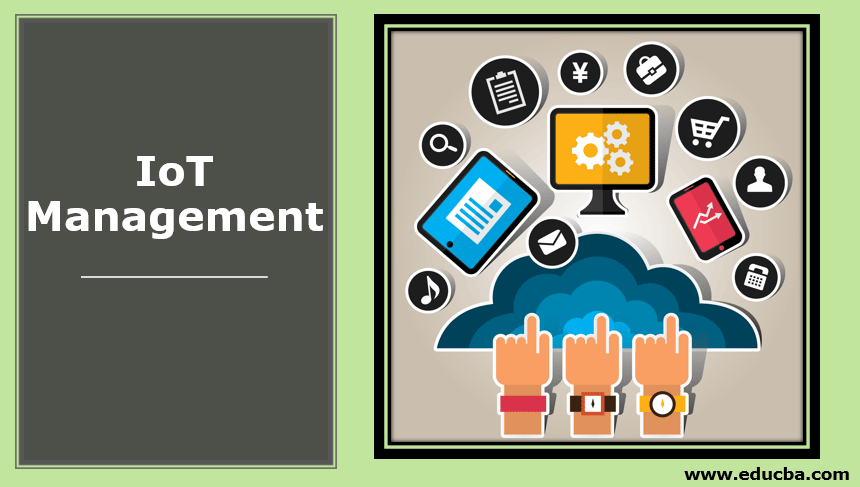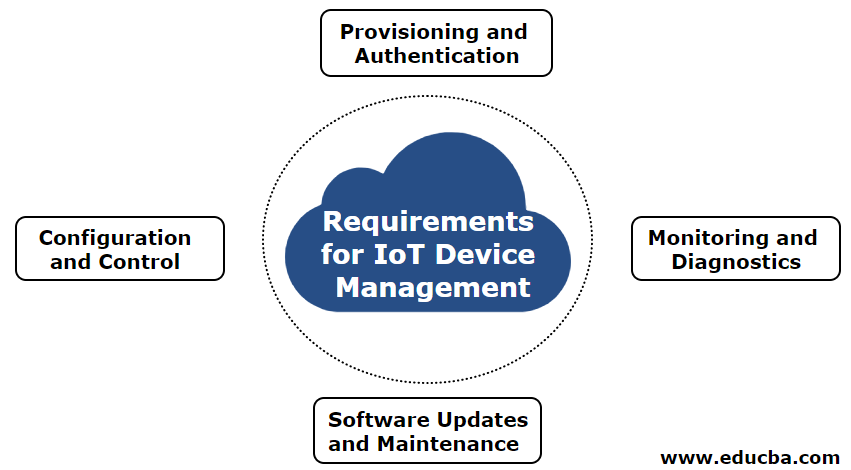Updated March 21, 2023

Introduction to IoT Management
Internet of Things (IoT) is an ecosystem where several devices are connecting with the help of the Internet. Things in the Internet of Things can be a tracker for GPS, an automobile with sensors, devices with temperature sensors, etc. These things have IP addresses which help in connecting the devices in order to collect and transfer data automatically without any intervention of humans. There are numerous applications where the Internet of Things can be used. Some of them are Big Data, Artificial Intelligence, Machine Learning, Cloud Computing, Radio Frequency Identification (RFID), predictive analytics, etc. Now, let us see what is IoT Management.
What is IoT Management?
IoT devices once installed may need software updates or bug fixes. Sometimes it has to be replaced or repaired. This may result in downtime. In order to solve what can we do? We can effectively manage the devices using IoT Device management. IoT device management is the method of authenticating, configuring, monitoring, provisioning and maintaining the software and device firmware that offers its functional capabilities. In order to maintain the security, health, and connectivity of the IoT devices, effective device management is essential. Normally, Solutions along with broad device management will also be provided by IoT application vendors.
Requirements for IoT Device Management
The following are the four basic requirements needed for IoT Device Management.
- Provisioning and Authentication
- Configuration and Control
- Monitoring and Diagnostics
- Software Updates and Maintenance
1. Provisioning and Authentication
As we know, the number of internet-connected devices is increasing day by day. Sometimes device manufacturers may fail to provide secure devices since they are not experienced in the case of security and it may cause malicious attacks from hackers. In some cases, users may not know whether the devices they are using are secure or not. Researchers found out that it is easy to attack the IoT devices since the way to enter the network is using the Internet. It is advised to make sure that only trusted devices must be added when using new IoT devices. In order to solve this, provisioning and authentication are done for the devices.
Provisioning
Provisioning is the process by which a device is enrolling in a system. It has two parts-
- By registering the device, the establishment of an initial connection between a device and an IoT solution is done.
- Based on the requirements of the particular solution, a configuration is done to the device.
Only after completing these steps, we can say that the device is fully provisioned. Some providers complete the first step and do not provides configuration. But, in device provisioning, both these steps are automated to offer smooth usage.
Authentication
Authentication is a process by which devices with valid credentials only get enrolled. It helps in trusting the device by validating an actual device is used with a trusted software and trusted the user. Even though the process of Authentication differs in each and every device, the device that is deployed will be having a certificate or key that checks whether it is authentic. When a new device is installed, it authenticates by validating credentials and several unique data such as model number, serial number, etc.
2. Configuration and Control
Whenever a new device is getting installed, there has to be some configuration done before start using. For example, a location tracker is the device that is installed in a truck and data is getting uploaded in the cloud every minute. Before start using that device, some settings have to be done in the device such as truck number, truck speed, truck driver name, etc. Otherwise, it may create some confusion on the same. Devices can be said as imperfect if this step is not done before start using. Even after deployment, the ability to control and configure devices is critical to ensure certain aspects such as functionality, performance, and protection from security threats. It is also advised to reset the devices to factory configuration before decommissioning them.
Also, the user needs to remotely reset the device to attain a good state, error recovery, and implementation of new configurations. This will help in implementing control capability in the system.
3. Monitoring and Diagnostics
Sometimes, there may be software bugs or certain other issues that can occur which in turn results in the downtime of the device. In order to solve the issues, the user needs to identify them first. For that, constant monitoring of devices is essential. Softwares with device management helps in diagnosing these issues by continuously logging. This software can also use certain cloud-hosted analytics to offer solutions.
4. Software Updates and Maintenance
When a device is installed, it needs to be updated for the flawless working of the device. Sometimes there will be additional functionalities to be included. As already said, devices are increasing day by day. So it is hard to update all the devices manually. The ability to update and maintain remote device software securely is thus one of the most important components of good device management. Let us see the same with the truck example mentioned above. If an update needs to be done, it can’t be done on a running track. So, before updating the software, make sure the truck is on rest.
Advantages of IoT Management
Following are the advantages listed below:
1. Know your Device
IoT device management helps the product owners to track, manage, monitor, track, sustain and secure the connected devices. Since the platform is associated with dashboard, it is also easy to remotely access and allows the devices to manage, decommission and provision them.
2. Less Operational Costs and Maintenance
With the help of device management, it is possible to undergo Predictive maintenance as an effective solution for periodic maintenance, and several other issues. Thus, the time consumed will be less and in turn, operation costs will be less.
3. IT and OT Convergence
In order to have a successful business, it is essential to have parallel coordination of information technology (IT) and operational technology (OT). It helps in a seamless flow of information to work parallel in different projects.
Conclusion
IoT Device management is a method of authenticating, provisioning, maintaining devices in the Internet of Things. Basic requirements and the advantages of IoT device management is discussed in the above sections.
Recommended Articles
This has been a guide to IoT Management. Here we have discussed the basic requirements needed for IoT device management along with its advantages. You can also go through our other suggested articles to learn more –

